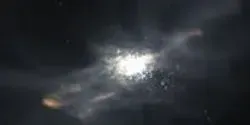Physics

Humanity is on the threshold of being able to detect signs of alien life on other worlds. By studying exoplanet atmospheres, we can look for gases like oxygen and methane that only coexist if replenished by life. But those gases come from simple life forms like microbes. What about advanced civilizations? Would they leave any detectable signs?

It may sound strange to say that nuclear weapons must survive radiation. But as part of its mission of ensuring the nation’s stockpile is safe, secure and effective as a deterrent, Sandia National Laboratories must make sure crucial parts can function if they’re hit by radiation, especially a type called fast neutrons.

Perimeter Associate Faculty member Matthew Johnson and his colleagues are working to bring the multiverse hypothesis, which to some sounds like a fanciful tale, firmly into the realm of testable science.

Light from tiny galaxies over 13 billion years ago played a larger role than previously thought in creating the conditions in the universe as we know it today, a new study has found. Ultraviolet (UV) light from stars in these faint dwarf galaxies helped strip interstellar hydrogen of electrons in a process called reionization.

In chambers that mimic Mars' conditions, University of Michigan researchers have shown how small amounts of liquid water could form on the planet despite its below-freezing temperatures.















